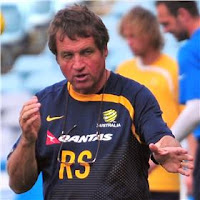Sourced from the SBS World Game, Craig Foster's Blog http://theworldgame.sbs.com.au/craig-foster/blog/1040063/My-message-to-the-fans
The SBS World Game held a Football Fan Forum in Sydney. They intend to do more of these forums around Australia. We need a Football Fan Forum in ACT.
Why doesn't Capital Football organise a series of community forums. What are they scared of? We need a lot of positive engagement with the community and Clubs and the Captial Football Board.
Craig Foster reflects on the first Football Fan Forum. Everything he says is absoutely correct. We should take the same approach in the ACT region and we can start with the game here in the ACT redion and work up through the A league and W League to the Socceroos and Matildas.
We have no one to blame but oursleves if we don't have the Football (and Futsal) environement we want for our chidlren and our talented young players.
My message to the fans
The start of a new fan movement?
I certainly hope so, having spent last night talking football with a considerable group of football lovers in Sydney alongside various dignitaries such as Mark Bosnich and Sydney FC’s Edwin Lugt.
What a valuable and heartening experience it was.
Among the crowd a group of supporters whose football involvement stretched from running clubs, such as Mark Ambour of Waverley Old Boys, the head of the Eastern Suburbs Associoation Peter Hennessy, the boys from The Football Sack - a staple of the football twittersphere, former Deputy Mayor of Woollahra Marcus Ehrlich, the Chairman of the National Indigenous Chamber of Commerce Warren Mundine to the many Sydney FC fans who eagerly took the opportunity to question Edwin directly and plead their case for more involvement and engagement.
It’s far too rare in football for everyone to come together, well, at least from the fans' perspective.
Football Federation Australia meets with the clubs and media. Players meet with the fans at various times. But the fans rarely have the chance to meet with those responsible for managing the game they love so much.
It is a phenomenon that is quite common abroad. In England, during my time at Crystal Palace, the Chairman and club owner and team manager would meet with the fans several times a season to talk directly.
This process was seen as necessary in the running of the club, within a football culture that recognizes the invaluable connection between the club and those who support it and keep it alive.
As any fan will tell you, the chance to speak directly and praise or voice frustrations brings them closer to the club and makes them feel an important part of the game.
Issues discussed last night ranged from the ticket prices at Sydney FC to the stadium suitability, player recruitment, the brand of the club and the confusion over what Sydney stands for over the past six years, marquee players and the value of Dwight Yorke in season one, and how Sydney can connect with the fans more regularly.
Much of the two hours were spent on the need for greater football understanding at head office and the necessity to engage our own football family who can ensure the survival and prosperity of the A-League. If the game will only reach out and make them a part of the journey.
The AFC Asian Cup was raised, and the question asked about what it can do for the game.
I congratulated FFA for its achievement in gaining the hosting rights for the 2015 edition of the tournament.
It is a fantastic achievement and a diplomatic success to be endorsed as the only bidder. I explained that the 2015 AFC Asian Cup offers Australia massive benefits in three areas: tourism, business and diplomacy.
:: Tourism because nothing else Australia can undertake can bring a billion Asian eyeballs to bear on the gifts our country has to offer, not even Oprah;
:: Business because Austrade’s Business Club Australia is skilled in using these tournaments to connect business leaders from the fifteen countries with our own at events built around the games;
:: Diplomatic because the opportunity for the Australian State and Federal Governments to engage with their brethren from many of our major Asian trading partners and political partners is extraordinary.
All of this serves simply to position football as the one game that can deliver such immense benefits for our relationship regionally.
FFA can leverage this position to continue football’s rise in both prominence and influence nationally.
There was a broad range of topics discussed and I was pleased to gain an insight into the frustrations and joys of being an Australian football fan, but in the end, after thanking all for showing their passion by coming along, I left the fans with the following challenge:
Get organized!
This must be the start of a new fan movement that sees all the disparate groups come together under an umbrella organization to focus the huge numbers who love the game into a single force.
I have said many times that if football ever gets organized as a single entity we are exceptionally powerful as the largest sporting constituency in the country, a power that can be wielded at all levels of commerce and government to ensure a greater share of resources the game needs by virtue of our size.
Well, now is the time.
Football is about emotion and the fans must separate their passion into the different areas: their club, the Socceroos and the game itself.
Parochialism reigns when it comes to one’s club, as it should. But when the national game and the national team are concerned, we all have a shared agenda, a combined mission to push the interests of the game, which takes collaboration.
So following from the success of the fans forum, I urge all the fan groups around the country to begin the process of getting together to create a single voice.
When this happens, Australian football will hit light speed in it's development.































